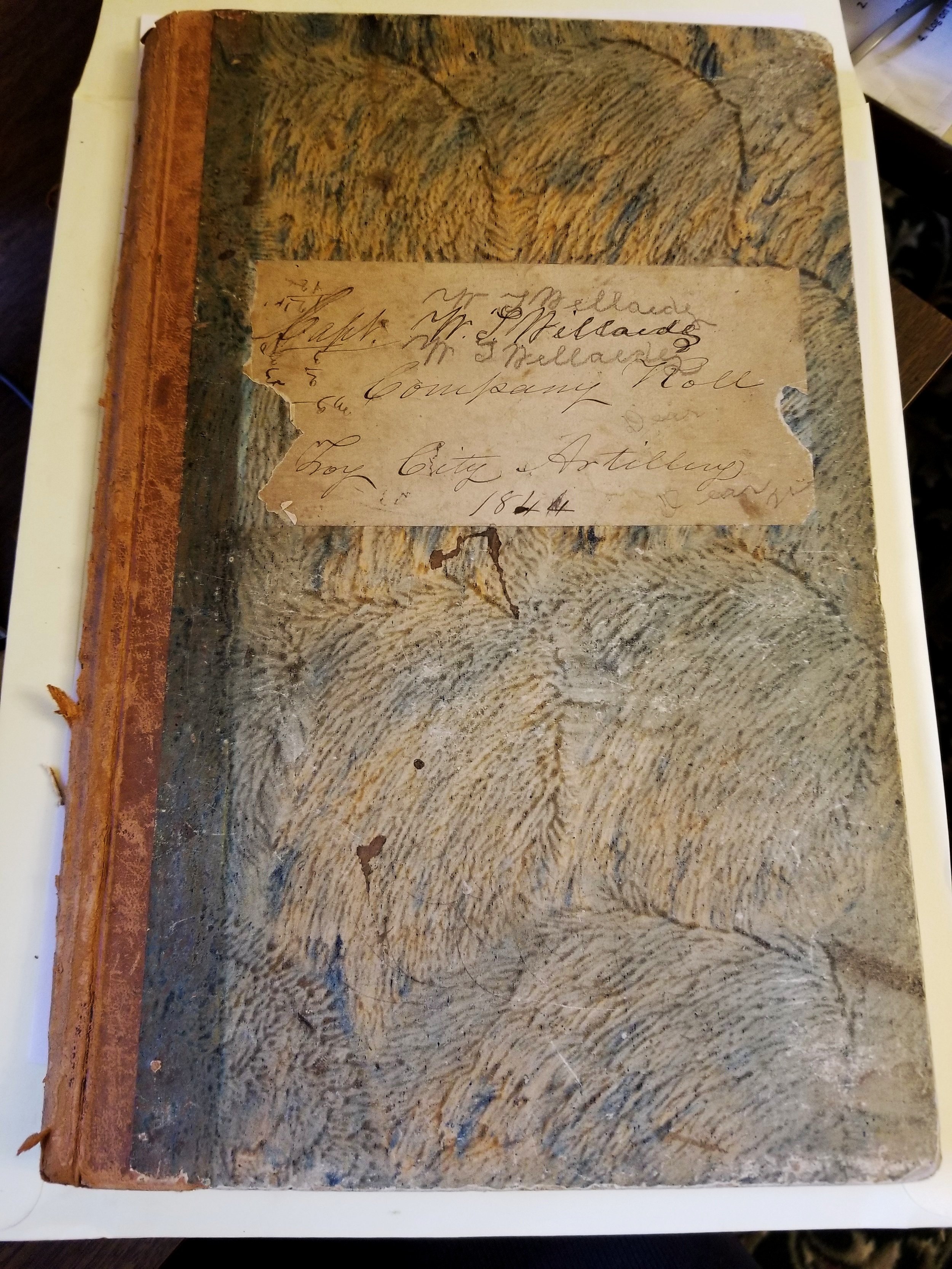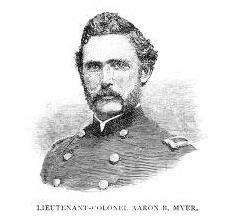The Troy City Artillery
The Troy City Artillery
We all learned as schoolchildren that American militiamen fought in the American Revolution, but what is the militia? It is the part-time military force, ready to step up when needed, made up of “citizen soldiers”, today’s National Guard. For the full history of the militia in New York State, we recommend a trip to the NYS Military Museum on Lake Avenue in Saratoga Springs, but the Hart-Cluett Museum recently acquired a little window into Troy militia history, thanks to a transfer from the Saratoga County History Center at Brookside: a portion of the Company Roll of the Troy City Artillery, from about 1844 until 1861. The book was begun by the Captain in 1844, William Tell Willard. There are pages missing, front and back, but the roster of men from 2nd Lieutenants down to Privates with surnames beginning with A through R, survives.
During the first half of the 1800’s, independent militia companies formed in many cities in New York State. The state had requirements for their equipping and training, which became stricter after about 1830. According to the Troy City Artillery Company Book, the term of service was seven years. The Troy City Artillery (TCA) had regular meetings at an armory, where they stored their artillery pieces. They went on at least one “excursion” per year, when they practiced live firing.
The Troy City Artillery began as “the Independent Fusiliers” during the War of 1812. The men marched to Plattsburgh too late to participate in the decisive battle there and came back home. After several name changes and reorganizations, the group emerged as the Troy City Artillery in 1844, with William Tell Willard as Captain. Willard (1796-1866) was the son of John Willard and his second wife, Mindwell Meiggs, born in either Connecticut or Vermont. John Willard’s third wife was Emma Willard, founder of the Troy Female Academy. I believe that Willard was in the US. military from at least 1816-1819. A 2nd Lt. WT Willard, born in Vermont was in the Navy register of 1816, and as a 1st Lt. at Ft Gadsden in Florida in 1819. So he came to his Captain’s position with experience.
William T. was in Troy by 1827, when he married Lucretia Paine, the daughter of Amasa Paine and the sister of John Paine, builder of the Paine Mansion. His father, John Willard, had died in 1825. William T Willard was a businessman. The 1847 Troy City Directory listed him as a forwarding and commission merchant for the Boston Packet and Flax agency, located at the dock at Adams St. He lived at 121 Second Street. In 1849 he was at 205 River Street, and ran the Philadelphia line with six schooners, 17 barges and 64 men. Willard served as postmaster of Troy during the Fillmore administration, from 1851-1853. By the 1860 Census, he was listed as an insurance agent. Besides the Troy Artillery, Willard was involved in the Troy Agricultural Society, and served as an organizer for a variety of ceremonies in the city right up until the year of his death.
The roster of the TCA lists men from all walks of life, from Stephen Alma, a druggist, to David Barringer, an ornamental painter, to Charles Brownell, a physician, to Edgar Ells, a mathematical instrument maker and John Flood, a blacksmith, to John Herrick, a moulder. Their occupations are a glossary of occupations of a mid-19th century city. As of 1858, the TCA had 41 members out of a possible 65. New members paid a $5 initiation fee, but got a full uniform and equipment in return. They were exempt from jury duty and from taxation on the first $500 of their property. They were paid $1.25 for each day on duty- usually about 10 days per year. This was a good amount considering that Civil War Privates received $12 a month in 1861. The photo of the T C A is taken at modern Monument Square, unfortunately without their cannon. It is in the collection of the Hart Cluett Museum.
The main duty of the TCA each year was to march in various parades in the city. The men also attended an annual commemoration of the battle of Bennington in Vermont each August, and put on a grand ball in honor of Washington’s Birthday each February. The Company was called out for a couple of weeks to the Helderbergs during the Anti-Rent Wars in 1839, though they did not fire a shot. In 1843 there was a “collision” in the streets of Troy on the 4th of July between “Two Foreign Associations”, one Protestant, one Catholic, “which ended in bloodshed.” The newspaper reported that the TCA was escorting the Protestants and charged upon the “Romanists” with fixed bayonets. 1849 was huge year for the TCA, as General John Wool, Troy’s own and a hero of the Mexican War, came home. There were parades and balls in his honor. William T. Willard was chair of the committee which presented Wool with a sword from the city of Troy that August. The sword is in the collection of the Hart-Cluett Museum.
When the Civil War began, the newspaper says that many members of the TCA enlisted in the 2nd NY Volunteer Infantry, which formed immediately after the outbreak of war in April 1861. Quite a few also enlisted in the 125th NY Volunteer Infantry, which formed in August 1862. They were the first two Rensselaer County Regiments. New men continued to enlist in the TCA, which acted as a home guard during the war, protecting the office where draft numbers were drawn in 1863, escorting the 2nd and 125th Regiments as they left and then arrived back in Troy.
Two examples of TCA men in the 125th NY follow. Aaron B. Myer, (1824-1864) a grocer, enlisted as a Private in the TCA in 1858. He quickly rose through the ranks, becoming a Sergeant by early 1861 and the Captain by the fall. He raised Company B of the 125th in August 1862, and was promoted to Major and Lt.-Colonel in 1863. He was killed in the battle of the Wilderness in Virginia on May 6, 1864. His remains were removed to Troy for re-burial in December 1865, with the TCA doing guard duty at the funeral.
Nelson Penfield, (1818-1866), was a collar cutter and night policeman, who enlisted in the TCA for the first time in 1842. He stayed beyond his required service, rising to be a Lieutenant by 1862, when he raised Company F of the 125th NY, becoming its Captain. He was injured by a falling tree at the battle of Cold Harbor in Virginia in spring 1864 and was discharged from the service due to that and disease. He returned to Troy, but was unable to work, and died in 1866.
A biography could be researched and written for virtually every member of the TCA listed in Capt. Willard’s Company Book. A few men left the unit because they went to California. Others besides Myer and Penfield served in the Civil War. One man was the first police detective in the city of Troy. This is just one more example of the ability of the Hart-Cluett collection to tell about “every face and every story.”
Blog Post by Christina S. Kelly





